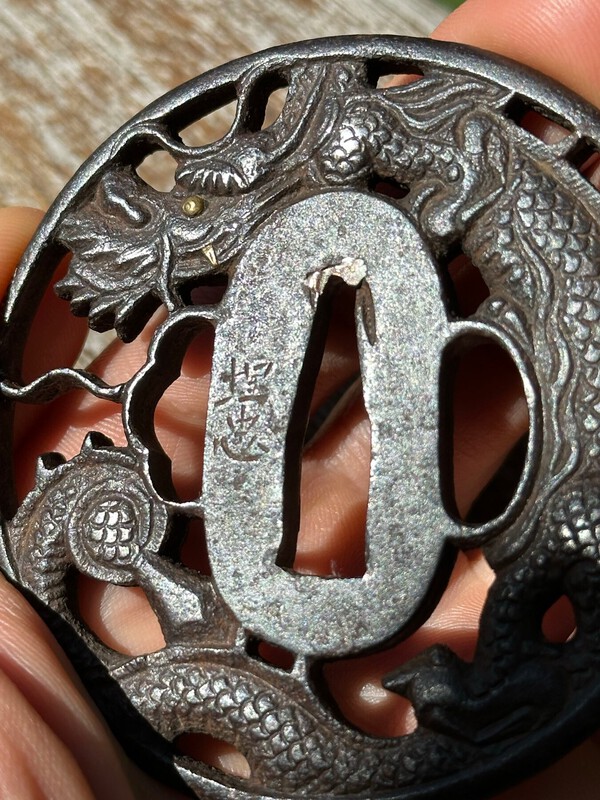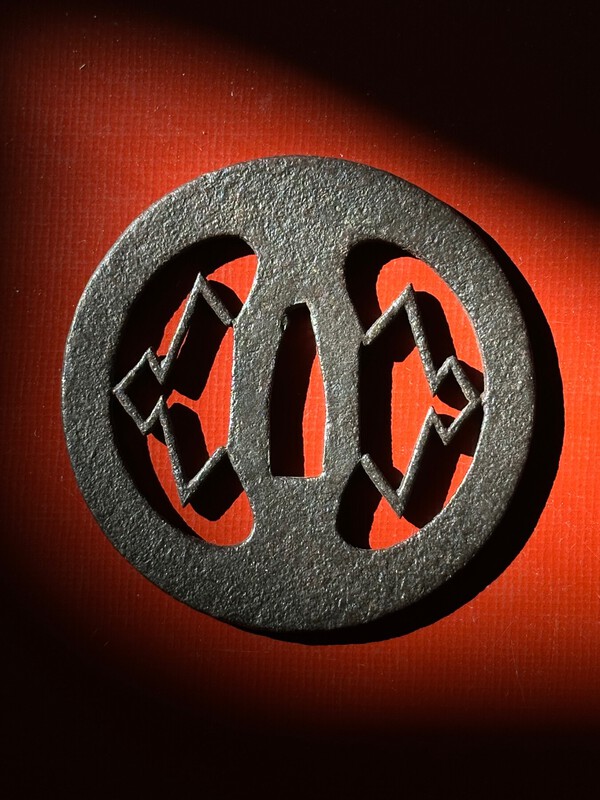-
Posts
23 -
Joined
-
Last visited
Content Type
Profiles
Forums
Events
Store
Downloads
Gallery
Everything posted by Mario Tod
-
This is the very chap. Well spotted. Definitely looking much happier now after it’s bath and some quite lengthy attention with a porcupine quill and Egyptian cotton.
-
For your appreciation today is a piece which I have recently restored. It had a fair amount of rust particularly in the recess. Now looking much more healthy. Interesting that this example is not cut all the way through like most of the examples of this style I can find online. I wonder why? it strikes me as very logical that this symbol was a demonstration of serene and skilful craftsmanship. I suppose the wearer was demonstrating to his audience a similar aspiration of equanimity. Your comments And observations would be most welcome. The extent of my notes concerning its description….. Iron, oval-shaped tsuba with openwork in “sayagata” pattern (interlocking buddhist “manji” symbols). Bushū Itō school. ? Sayagata is a pattern of interlocking manji. The Manji symbol is a testament to the Buddhist ideal of interconnectedness. It signifies the interdependence of all phenomena, emphasizing that each individual being is intricately linked to the vast web of existence. This interconnectedness fosters compassion, empathy, and a sense of responsibility towards all beings. The Manji serves as a reminder of our shared humanity and the interconnectedness of our actions, highlighting the importance of cultivating kindness and mindfulness in our interactions with others. I can’t think of better words at the moment to encourage us to all reflect on ways of living in these difficult times…..
-
A male and a female! What great symbolism. Thanks for the education guys🙏
-
For today I present you this piece. Two dragons chase each other through the sea. One has already lost its tail to the aggressions of the other. There are traces of gold inlay here and there including some quite charming gold tenzogan. As with my other dragon piece I have no illusions that this is a masterpiece but it was the second tsuba to come into my possession so it forms part of a growing awareness of the form and the mark making of the craft. Does anyone have any particular insights as to the narrative of the two dragons or any other observations with regard to place or date for this. Thanks guys.
-
Thank you so much Ford and others for your insights. I'm glad to say I didn't pay very much for this piece, $250, The most I have ever paid for a Tsuba, and I'm not in any way disappointed by Ford's assessment. As a novice collector it's extremely interesting to begin to educate myself as to the depth of this art form. I had no illusions that this was a masterpiece. It's amazing the way more and more examples keep coming out. The previous owner of this piece would have been fascinated by this discussion. This piece and most of the others in my collection come from a single previous collection that was assembled here in Cape Town in the 1950s. The previous collector would have been in his early 30s at the time and a novice in the subject. Lovely to now assemble this research and pair it with the pieces so that the next custodian will be able to further the research and not have to repeat it. Thank you everyone for your engagement and interest. I will slowly over the coming days and months share the rest of my collection for your enjoyment and scrutiny.
-
Excellent. Very useful advice. Thank you so much David 🙏
-
Is this the Man ? Yoshinobu Submitted by kazarena on Mon, 2007-05-14 20:13 吉信 初代 [Help] △ 寛永︱ 山城 Yoshinobu (1st gen) ID YOS656 Province Yamashiro Era Kanei (1624-1644) Active Period 1624-1644 Teacher Myoju Lineage Image / Interactive Source Rating Reference/Page Hawley 90 YOS656 Toko Taikan ¥4.5M 739 Signatures: 山城國住埋忠吉信 yamashiro kuni ju umetada yoshinobu 山城國西陣住埋忠吉信 yamashiro kuni nishijin ju umetada yoshinobu Biography and lineage Held Yamato Daijō and Yamato no Kami titles. Workmanship and style Fine horimono. https://nihontoclub.com/smiths/YOS656
-
Hello everyone. I've done some very rudimentary research on this piece as I am still new to the field. Would anyone be able to pin down a slightly more accurate appraisal? Signed: Echizen ju Kinai Date: 18th century Mei: Echizen Ju Kinai A description very similar piece., . The design of RYU, a stylised dragon, is depicted, the head to tail around the SEPPA DAI, shown flying across the clouds and holding a flaming TAMA, a Japanese jewel. TECHNIQUE Pierced in YO SUKASHI, positive silhouette, with KEBORI light hairline incised surface details, which would indicate his style as well, the eyes of the dragon inlaid in gold. SIGNATURE / SCHOOL 越前住記内作 ECHIZEN JU KINAI SAKU KINAI school. PERIOD / ORIGIN Middle EDO period. 18th century. Japan. To see the body of a dragon in its entirety was thought to expose oneself to certain death, the punishment for looking upon too much divinity: the eating off the tree of knowledge. This idea is also said to be the reason why formerly the Japanese emperor, who through his forbears was said to be descended from a dragon, was always hidden by a bamboo curtain from those he received in audience. Possibly a branch of the Miōchin (Group IV), this family was founded by Ishikawa Kinai, who moved from Kiōto to Echizen province and died in 1680. The succeeding masters, however, bore the surname of Takahashi. All sign only Kinai, with differences in the characters used and in the manner of writing them. The Kinai made guards only, of hard and well forged iron usually coated with the black magnetic oxide. They confined themselves to pierced relief showing extraordinary cleanness both of design and execution. Any considerable heightening of gold is found as a rule only in later work. Dragons in the round appear first in guards by the third master, fishes, birds, etc., in those of the fifth; while designs of autumn flowers and the like come still later. Thanks very much everyone.
-
Thank you so much David!
-
Thanks so much Florian. I appreciate your observations and have amended my catalogue notes accordingly.🙏
-
Hello everyone. Today I would like to share this lovely piece with you and hear any interesting insights or comments you may have. Ko-katchūshi tsuba with design of matsutake mushrooms. Mid Muromachi period.? 7 cm wide 8 cm high 5 mm mimi The style of rim is turned up and hammered back is referred to in Japanese as sukinokoshi-mimi and if often observed in Saotome and Tempo school tsuba. Matsutake are considered highly symbolic in Japanese due to their rapid overnight growth. I’m sure other amusing and self affirming symbologies must have been in their mind of the maker and the wearer. The extreme age of this piece and the beautifully simple pierced design really captivate me. I have only acquired it recently and plan to give it an extremely gentle clean and apply micro crystalline wax in the not too distant future.
-
That’s a really intelligent take Dale. We definitely get very bogged down in the superlative academia of school attribution as you say. I suppose we also are looking for easy answers to complicated questions as always. Thank you so much for your insight! I can definitely feel my mind is beginning to relinquish its requirement to know a close date or attribution for this piece and just begin to enjoy how marvellously ancient and amazing it is more than anything else.🙏🧘♂️
-
Thanks for the welcome Brian and thank you Big for the link. I’ve looked on that site quite a bit but missed that piece. That quotation is fabulous and the history is definitely very stirring. Thanks again guys
-
I’d say it’s a Japanese 1940s era mass produced gunto https://www.Japanese...dex.com/military.htm very possibly made for naval use as it looks like it’s stainless steel. fun!
-
Of the many Tsubas in my collection this is one that I know the least about. Am I correct in guessing that it's late 18th to 19th century? Does anyone have any hunches as to its origin and the school of craftsmanship? The workmanship is extraordinary and I'm surprised it isn't signed. The scene depicted seems intriguing. A travelling monk holding a water gourd is startled by a wild horse during his travels beside a river as he passes beneath a particularly beautiful flowering? tree on a windy day.......? I would imagine it must be from at least Japanese or possibly Chinese methodology? Thanks to everyone for taking a look at this. I actually just happened upon this, a legend I knew nothing about. "In Japanese there is a saying hyōtan kara koma, ‘a horse appearing from a gourd’. It is used when something completely unexpected, even unbelievable, happens. It refers to the legend of Chokara Sennin, an immortal being who owned a horse that when necessary, could be conjured up from his gourd as if by magic. This expression reminds us that in life the unexpected can happen. Nature is as nature befits, fickle and unpredictable."
- 1 reply
-
- 5
-

-
Thank you so much guys. I have looked at those links in my attempt to identify this piece and it's definitely an ancient and intriguing crossover of aesthetic styles and schools. Thanks for the welcome and thanks for your insights.
-
Hello. My name is Mario and I live in Cape Town South Africa. I'd like to ask if anyone could help shed some more light on this very intriguing piece. I am reasonably sure that it is Kiribun Sankai Hishitsu (Owari) Muromachi period - Momoyama period -early Edo period. ?? Rich T, a member of this very forum observed in 2007 of a very similar piece " The Hitsu-ana are pine trees, they represent a design (and also a family crest) known as Matsukawabishi which also means pine bark diamond. They represent two stylized pine trees" The one thing that really has me intrigued is the tiny fragment remnants of gold on the front, which can be seen in the third image near the centre top and on the right diamond at the top left base. I also believe the quality of Owari iron was exceptional and led to a very desirable and aesthetic oxide patina known as purple rust. Any context and observations would be extremely valuable and I'm grateful to everyone. Thanks very much.




















